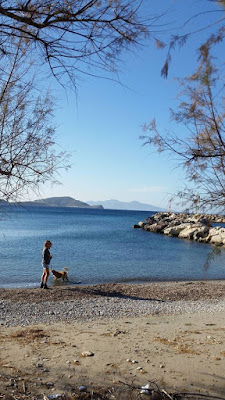 |
| Thanks to Eleftheria for this photo of Lisa trying to pull me into the sea at Ayios Antonis! |
This might be my favourite time of year; I can sit here with the sun warming my arm and the occasional bee buzzing through the open window, while in the evenings, even though there’s no real need for heating, it’s sometimes cool enough to light a fire in the hearth. Even though I wouldn't call myself a flower fanatic, it's impossible not to be wowed by the fields bursting with colour, and the tiny orchids. And I’m seeing hoopoes! Hoopoes seem shy and I’ve never been able to get a photo, but they have ginger mohicans and black-and-white striped tails.
If you want to experience a different kind of Easter, you still have time to book
a flight to Greece for the ‘Big Week’. You won’t find much in the way
of chocolate eggs but it’s very beautiful and brings the community together, from its mournful
processions with a flower-covered bier to the firecracker-popping end with lamb
or kid roasted on the spit and the burning of Judas. Easter Sunday will coincide this year with Protomayia, the First
of May, a national holiday when everyone gathers flowers and hangs wreaths on
their front doors, marking the start of summer.
There are plenty of reasons to
be thinking of Greece in the coming month leading up to Greek Easter – here are
a few….
- * My Big Fat Greek Wedding 2 – the movie is
launched this week (!)
- * The Durrells, a
six-part series based on Gerald Durrell’s books about his childhood on the
Greek island of Corfu, is starting on 3 April (
- * Five chefs from Athens are taking over The Real
Greek in London’s Bankside on 19 April, hosted by Tonia Buxton, presenter of My Greek Kitchen.
- * Athens has been voted #2 Best European
Destination for 2016
- * My Map
of You by Isabelle Broom, set on the island of Zakynthos, is out on 21
April
- * An
Octopus in my Ouzo, by… oh yes, by me… is out 14 April!!!!!
To rest up a little
before the big launch, ahem, I’m looking forward to few little holidays. What? Yes, I
know I live on a Greek island. In fact, this is what I just saw when I took the
dog for a mid-morning stroll around the village….
But sometimes it’s fun to see
other Greek islands too, especially ones not very far away. First up, Y and I
are off to Rhodes this time next week, for errands (because it’s our
nearest ‘city’) and then for pleasure. We’ll be staying for a couple of nights
at the lovely NikosTakis Hotel –
described in my new book – in the heart of the Old Town near the Palace of the
Grand Masters; then assuming Y’s car passes its MOT we’ll be doing a fast tour
of the island… And the following weekend I’ll be with my mum in Lindos, staying
at this traditional Captain’s House run by Exclusively Lindos, which
promises to be a treat.
If you haven’t seen the Alpha
TV show 60 Lepta Ellada when they
came to Tilos in February, you can now see it online here (Lisa and
I get our three minutes of fame around minute 16, though several people brought
me down to earth by saying that Lisa was the real star). I had some lovely
messages from viewers in other parts of Greece and made some new friends. ‘You
have touched the meaning of life!’ wrote Yiannis. Stavros wrote to say he’d
been to Tilos 20 years ago and the show brought back wonderful memories. Tassos
said he was jealous of my life, and thanked me for helping people to learn about his
country. Costas wants to learn the key for escaping from a life dominated only by
work. And Ilias said he liked to see people enjoying nature and doing what they
want in life, not what others want. I now want to watch all the episodes about
other parts of Greece, though it will make me want to travel more….
In the meantime, it’s Lent
here, so it’s almost obligatory to eat halva, the delicious sweet. Last week, to get into the spirit of things, I
cooked fasolada, a thick soup of
white beans with carrots, celery, tomatoes and olive oil. Yesterday, around
this hour, I heard the shout of ‘Psaria!’,
or ‘fish’, and walked down to the road to buy fresh gopes from Nikos’ truck. We grilled them last night and I picked a
lemon off my tree to squeeze over. I boiled local potatoes and we sprinkled them
with salt and oregano and drizzled them in local olive oil. With a mound of salad
and a glass of ouzo... It’s not bad, life on a Greek island.
With apologies to those of you who might already have seen some of these photos on my Facebook page, I'll leave you with some snaps from my walk up to the old Italian Observatory last week. Enjoy yourselves, wherever you are and whatever you're doing... X

